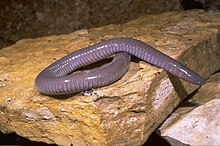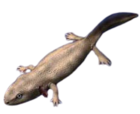For faster navigation, this Iframe is preloading the Wikiwand page for
无足目 .
解剖
无足目的动物的脚已经退化,造成其中较小的种类看起来像蠕虫,而比较大的种类(长度可到1.5米)则看起来像蛇。四肢 及带骨均退化,尾巴很短极或无尾,因此泄殖腔 接近身体的尾部。全身裸露,体表有皮肤皱褶形成的数百条覆瓦状环褶,环褶内有次级环褶及围绕体轴呈环状排列的骨质圆鳞(水生种类无此结构),这说明它们与坚头类 (学名:Stegocephalia)化石有关。由于它们生活在地下,眼睛很小,并覆盖一层保护皮层。所有无足目的动物头部鼻眼见近颌缘的凹槽内都有一对触突,伸长时可达2mm~3mm,可以起到额外的嗅觉作用。
体长10-150厘米,直径最大为5厘米。颜色从浅黑到粉棕色不等。眼小,隐于皮下甚至于骨下。雌雄外观相似。卵生或胎生。生活在地下,以蠕虫或昆虫为食,而蛇又常以它们为食。
除了在南非发现的艾氏盲游蚓(Typhlonectes eiselti )[1]
分布
蚓螈分布在除了干旱地区和高原外的绝大部分的东南亚、非洲和南美的热带地区。在南美,它们的分布一直延伸至阿根廷温湿的北部。中非的系统探寻蚓螈的工作还未展开,但是在那里的热带雨林中找到蚓螈的可能性非常大。版纳鱼螈 (Ichthyophis bannanicus )是中国产的唯一一种蚓螈,分布于云南 、广西 和广东 。2012年2月,科学家在印度东北部发现了一个新的无足目分支Chikilidae科[2] [3]
繁殖
无足类是两栖类中唯一进行体内受精的种类。雄性蚓螈具有类似阴茎 的器官(phallodeum),在交配时插入雌性的泄殖腔中,持续2到3小时。大约25%的蚓螈为卵生,雌性负责保护卵,以皮肤表面的粘液保护其免致干燥。其余75%的蚓螈为卵胎生 。
分类
按照科学分类法,无足目分成6个科。下列的种类数目可能有误。有些种被重复统计。一方面,统计并没有完全纳入所有的种类,另一方面,被统计为不同种类的种有可能只是某一种类的变种。
吻蚓科 (Rhinatrematidae) - 2个属, 9个种
鱼螈科 (Ichthyophiidae) - 3个属, 46个种蠕蚓科 (Scolecomorphidae) - 2个属, 6个种
真蚓科 (Caeciliidae) - 26个属, 107个种盲游蚓科 (Typhlonectidae) - 4个属, 12个种
参考
^ 中国生物多样性信息中心动物学分部:动物名称数据库 . 中国生物多样性信息中心动物学分部. [2009-02-03 ] . [永久失效链接 ^ Kamei, R.G.; San Mauro, D.; Gower, D. J.; Van Bocxlaer, I.; Sherratt, E.; Thomas, A.; Babu, S.; Bossuyt, F.; Wilkinson, M.; Biju, S. D. Discovery of a new family of amphibians from Northeast India with ancient links to Africa . Proc. R. Soc. B. 2012, 279 (1737): 2396–401. PMC 3350690 PMID 22357266 doi:10.1098/rspb.2012.0150 ^ New amphibian family found in India . CBC News. Associated Press. 21 February 2012 [2019-08-20 ] . (原始内容存档 于2013-06-19). 滑体亚纲 Lissamphibia
蚓螈类 Gymnophiona 蛙总目 Batrachia
† 异螈目
阿尔班螈科
阿尔班螈属 Anoualerpeton Celtedens 白螈属 威斯螈属 夜叉螈属
蚓螈型类(蚓螈总群)
† 曙蚓螈属 † 前卫虫螈属 † Rubricacaecilia † 钦尔蛇螈属 † 阿尔班螈科 蚓螈类 (蚓螈冠群 )
蠕蚓科 Chikilidae 禾帕蚓科 盲游蚓科
闭管螈属 带子蚓属 北盲游蚓属 考氏水蚓属 盲游蚓属 † Ymboirana 真蚓科 格兰蚓科
吉歌蚓属 格兰蚓属 海迫蚓属 埃德蚓属 印度蚓属 盘西蚓属 Sylvacaecilia 蛇皮蚓科 Siphonopidae
蛙总目(蛙+螈
有尾类(蝾螈总群)
† Egoria † Kulgeriherpeton † 三叠螈属 † Urupia † 卡拉螈科
卡拉螈属 Kokartus Kuzbassia Marmorerpeton † 蛙蜥螈科
蛙蜥螈属 Opisthotriton Palaeoproteus Parrisia Peratosauroides Prodesmodon 有尾目 (蝾螈冠群)
跳跃类(蛙总群)
{{bottomLinkPreText}}
{{bottomLinkText}}
This page is based on a Wikipedia article written by
contributors (read /edit ).CC BY-SA 4.0 license; additional terms may apply.
{{current.index+1}} of {{items.length}}
Thanks for reporting this video!
This browser is not supported by Wikiwand :(
An extension you use may be preventing Wikiwand articles from loading properly.HTTPS Everywhere or you're unable to access any article on Wikiwand, please consider switching to HTTPS (https ://www.wikiwand.com).
An extension you use may be preventing Wikiwand articles from loading properly.Ad-Blocker , it might have mistakenly blocked our content.
You will need to temporarily disable your Ad-blocker to view this page.
✕
This article was just edited, click to reload
Please click Add in the dialog above
Please click Allow in the top-left corner, Install Now in the dialog
Please click Open in the download dialog, Install
Please click the "Downloads" icon in the Safari toolbar, open the first download in the list, Install
{{::$root.activation.text}}
Follow Us
Don't forget to rate us
Oh no, there's been an error
Please help us solve this error by emailing us at
support@wikiwand.com
Let us know what you've done that caused this error, what browser you're using, and whether you have any special extensions/add-ons installed.
Thank you!


 . PMID 22357266. doi:10.1098/rspb.2012.0150.
. PMID 22357266. doi:10.1098/rspb.2012.0150.






